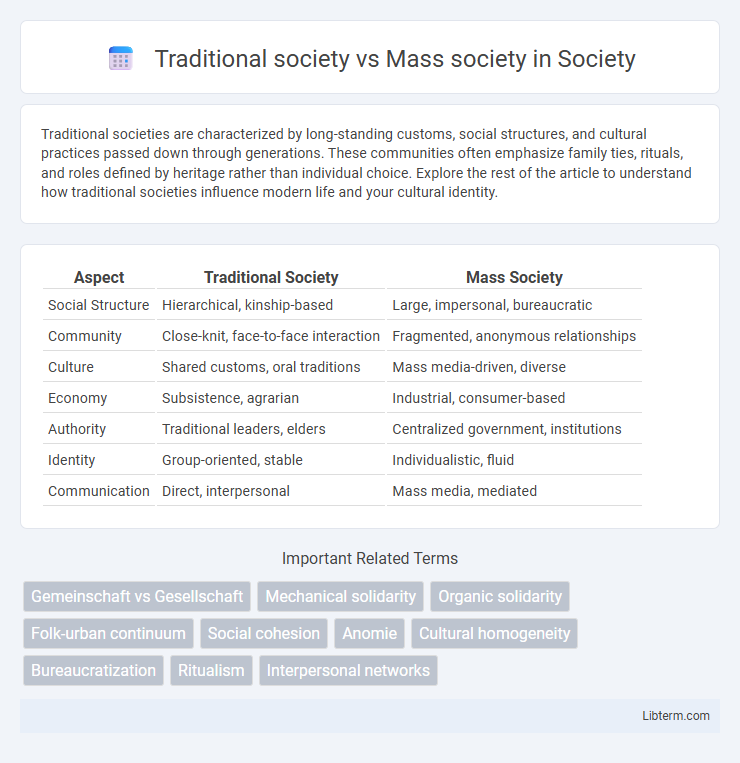Traditional societies are characterized by long-standing customs, social structures, and cultural practices passed down through generations. These communities often emphasize family ties, rituals, and roles defined by heritage rather than individual choice. Explore the rest of the article to understand how traditional societies influence modern life and your cultural identity.
Table of Comparison
| Aspect | Traditional Society | Mass Society |
|---|---|---|
| Social Structure | Hierarchical, kinship-based | Large, impersonal, bureaucratic |
| Community | Close-knit, face-to-face interaction | Fragmented, anonymous relationships |
| Culture | Shared customs, oral traditions | Mass media-driven, diverse |
| Economy | Subsistence, agrarian | Industrial, consumer-based |
| Authority | Traditional leaders, elders | Centralized government, institutions |
| Identity | Group-oriented, stable | Individualistic, fluid |
| Communication | Direct, interpersonal | Mass media, mediated |
Defining Traditional Society
Traditional society is characterized by close-knit social structures, where relationships are primarily based on family ties, customs, and long-established cultural norms. Social roles and statuses are often ascribed rather than achieved, with a strong emphasis on community cohesion and continuity. Economic activities typically revolve around agriculture and craftsmanship, reflecting a preservation of ancestral practices and limited technological advancement.
Characteristics of Mass Society
Mass society is characterized by large, impersonal social structures where individual identity often diminishes in favor of collective norms. It features widespread industrialization, urbanization, and the prevalence of mass media that shapes public opinion and social behavior. Social bonds in mass society are more fragmented compared to the close-knit communities found in traditional societies, leading to increased social mobility and diversity.
Historical Evolution: From Tradition to Mass
Traditional societies were characterized by close-knit communities with shared customs, limited social mobility, and economies based on agriculture and craftsmanship. The Industrial Revolution triggered a shift towards mass societies, marked by urbanization, mass production, and diversified social roles. Technological advancements and increased communication accelerated this transformation, reshaping social structures and cultural norms on a global scale.
Social Structure and Organization
Traditional societies emphasize kinship-based social structures with clearly defined roles, hierarchical authority, and communal interdependence, where status is often inherited and social organization revolves around family, tribe, or village units. Mass societies are characterized by impersonal social relations, complex division of labor, and institutionalized organizations such as bureaucracies and corporations that prioritize individual roles over communal ties. The shift results in greater social mobility but also increased social fragmentation, where formal institutions replace personal relationships as the primary means of social cohesion.
Family and Community Roles
Traditional societies emphasize close-knit family structures with clearly defined roles where extended family members contribute to social support and cultural continuity. In contrast, mass societies often exhibit fragmented family units and diminished community bonds due to urbanization and industrialization, leading to more individualistic lifestyles. The shift reduces communal responsibilities and alters social roles, impacting identity formation and social cohesion.
Authority and Leadership Differences
Traditional society is characterized by authority rooted in customs, hereditary hierarchy, and personal relationships, where leadership often derives from established family lineage or tribal elders. Mass society features more impersonal authority structures, centralized institutions, and leadership based on formal roles, bureaucratic organization, and ideological legitimacy. The shift from traditional to mass society reflects a transition from personalized, localized leadership to standardized, institutionalized authority mechanisms.
Cultural Transmission and Values
In traditional society, cultural transmission occurs primarily through face-to-face interactions within close-knit communities, ensuring the preservation of long-standing values, customs, and norms passed down from generation to generation. Mass society, characterized by industrialization and urbanization, relies heavily on mass media and other impersonal institutions to disseminate cultural values, often leading to more homogenized and fragmented social norms. This shift results in weakened community ties and challenges in maintaining cohesive collective identities.
Social Control and Norms
Traditional society relies heavily on informal social control mechanisms and strong, shared norms rooted in kinship, religion, and long-established customs that guide individual behavior. Mass society features formal social control institutions, such as laws, police, and regulatory bodies, to manage diverse and often impersonal social relations, where norms are more fluid and less collectively enforced. The shift from cohesive, small-scale communities to large, industrialized populations transforms social norms from internalized moral codes to external rules enforced by centralized authority.
Impact of Technology and Media
Traditional society relies on face-to-face interactions and community-based knowledge transmission, whereas mass society is characterized by large-scale social structures influenced by technological advancements and mass media. The proliferation of digital technology and media platforms has accelerated information dissemination, reshaping social norms and individual behaviors within mass societies. This shift reduces the role of localized cultural practices found in traditional societies, fostering more homogenized global communication and social integration.
Challenges and Future Perspectives
Traditional societies face challenges such as limited technological advancement and rigid social structures that hinder adaptability to rapid change. Mass societies struggle with issues like social alienation, loss of community identity, and increased dependence on mass media, which affect social cohesion. Future perspectives emphasize integrating technological innovation with cultural preservation, fostering inclusive social policies, and enhancing digital literacy to build resilient, adaptive communities.
Traditional society Infographic

 libterm.com
libterm.com